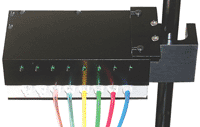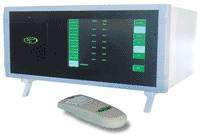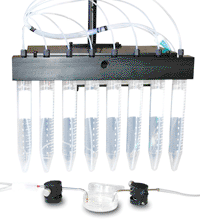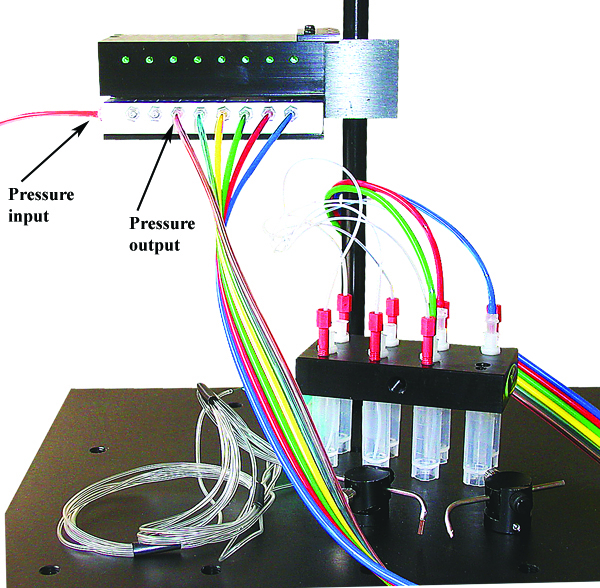|
|
| |
|

8-Channel pressure switch, PS-V8P
This small manifold can deliver pressure to eight independent outputs - channels.
If connected to sealed containers, small volume manifolds or cylinders,
the pressure switch can deliver solutions to any custom chamber or fluidics device (no syringe pump or gravity driven perfusion is required).
Can be used with any volume containers, including transfer
bottles. Can be also used with zero-dead volume manifolds to deliver solutions into small
chambers and dishes.
Requires a pressure pump and the valve controller. The controller can be programmed
to deliver solution sequences and for continuous periodic solution
replenishment.
The switch is rated up to 150 PSI input pressure. It has a secondary threaded input port for
the balance pressure to prevent back-flow. Dimensions: 5x2x2in.
Sample publications.

Programmable 8-Channel liquid delivery system, PS-8P
In addition to 8-channel pressure switch PS-V8P, this setup includes 16-channel programmable valve controller
with built-in
0-15PSI pressure controller-pump, adjustable stand SH-1A, small volume manifolds SVDS1 and SVDS2, and sets of pressure cylinders
PC-10 and PC-50 (x8 each), connecting tubing and fitting.
Can deliver solutions to any custom chamber or fluidics device (no syringe pump or gravity driven perfusion is required).
Can be also used with zero-dead volume manifolds to deliver solutions into small
chambers and dishes. Compatible with LabView, MatLab, pClamp, IPlab, PatchMaster, Metamorh, MetaFluor
The controller opens valves through
- manual buttons
- wireless remote control
- optically isolated digital or TTL signals generated by a computer or other equipment
- analog signal
- RS232 port (or USB connection) for software control
Specifications: |
Valve Fitting: | barbs for 1/16in. I.D. soft tubing |
Remote control: | Wireless |
Pressure controller: | 0-15PSI pump |
Height: | up to 3ft. adjustable, for gravity driven solution flow |
Solution cylinders: | 10ml x8 syringes, 50ml x8 syringes, 8-channel manifolds SVDS1 and SVDS2 |
Tubing: | 8-channel
color-coded 2-feet long tubing for the manifold;
50ft. Tygon tubing, fits provided barbed luer connectors |
Tubing Fitting: | barbed luer-locks to connect to solution cylinders
and manifolds |
Anti-vibration mounting: | a. 1x1 ft. stand,
b. magnetic stand,
c. M8 threaded surfaces |
 The controller can operate in
AUTO Memory mode, to
program timers and channels sequences
for precise timing during manual operation;
The controller can operate in
AUTO Memory mode, to
program timers and channels sequences
for precise timing during manual operation;
INHIBIT mode with manual and external controls allows you to
switch all channels OFF at once, if required.
The controller has an
option for valves control by Binary Encoding using only 2-4 digital
inputs, in case if a limited number of digital outputs are available
in your system. The RS232 port allows automation of solution
switching and integration with data acquisition and imaging systems.
SET output is used to switch an
outflow unit ON automatically every time perfusion is ON.
RS232 port allows software control by any imaging or data acquisition
setup. Can be upgraded to USB/RS232 adapter.
Comes with an external 120/220V power supply.
Specifications (controller): |
Channels: | 16 |
Controls: | optically
isolated digital signals and TTL, Analog input, RS232 software command |
Manual Overdrive: | Manual
touch-pad switches, override electronical inputs |
Remote control: | Wireless |
Auto Memory: | To
program timers and channels sequences for precise timing
during manual operation |
Code mode: | Use only 4 TTL inputs to encode all channels |
Close mode: | Inhibits all outputs to the valves, manual and electronical inputs |
Analog and SET outputs: | To switch outflow units
CFPS-1U and for telegraph
output |
Custom modifications: | Additional features can be added or modified on request |
Dimensions: | 2.5 x 12 x 9 in. |
Power: | 120/240 VAC
internal power supply |

Small Volume Delivery System with pressure switch, SVDS2-P
This is the same SVDS2 manifold for 15ml tubes with incorporated pressure switch, which is controlled by
PC-16 controller.
It allows you to connect tubes directly to the manifolds without using valves.
Ideal for use with custom fluidics devices and zero-dead volume manifolds
that do not have back-flow. The system has a secondary input port for
the balance pressure to prevent back-flow. The valve controller can be programmed using built-in timers to generate solution sequences.
Requires pressurized gas to
deliver the solutions.
The system comes with all necessary tubing and fitting to connect to a pressure source and to the manifolds or sample chambers.
The small size allows to position solutions near your sample.
Comes with X-block to attach onto a standard 0.5 in. stand. Includes
replaceable plastic tubes x8 15ml, PTFE tubing, fitting and
tubing to connect to a pressure source, and cable to connect to the valve controller.
Click on catalog numbers below to purchase online.

Required accessories: a pressure controller, or
flow control units.
Optional accessories: a solution switch or a pressure switch,
miniature manifolds.
Download PDF manual.
Download PDF catalog.
|
|
Bioscience Tools
ph: 877-853-9755, fax: 866-533-7490
email: info@biosciencetools.com
|
PRICES AND OPTIONS |
PS-V8P |
$295 |
8-Channel pressure manifold-switch
|
SVDS2-P |
$495 |
Small Volume Perfusion System SVDS2 with pressure switch
|
PS-8P |
$3,595 |
Programmable 8-channel liquid delivery system
|
Sample publications:
3
Exocytotic release of ATP by preBötzinger Complex astrocytes contributes to the hypoxic ventilatory response via a calcium-dependent P2Y1 receptor mechanism;
1
Basolateral and central amygdala differentially recruit and maintain dorsolateral striatumdependent cocaine-seeking habits.
NATURE COMMUNICATIONS 14 Dec 2015;
2
Spatiotemporal Coding of Individual Chemicals by the Gustatory System.
The Journal of Neuroscience, 2 September 2015, 35(35): 12309-12321;
|
|